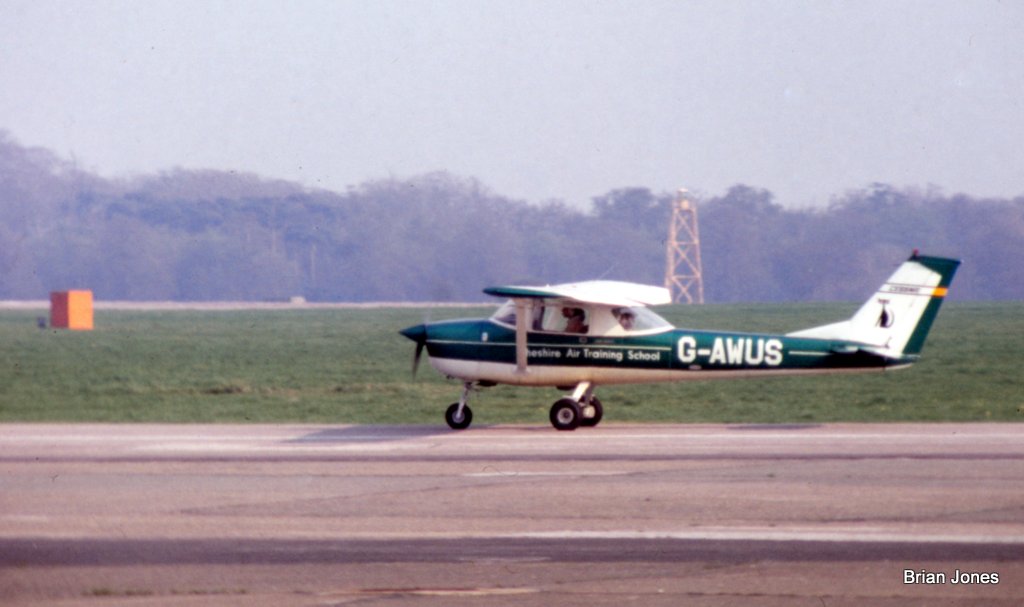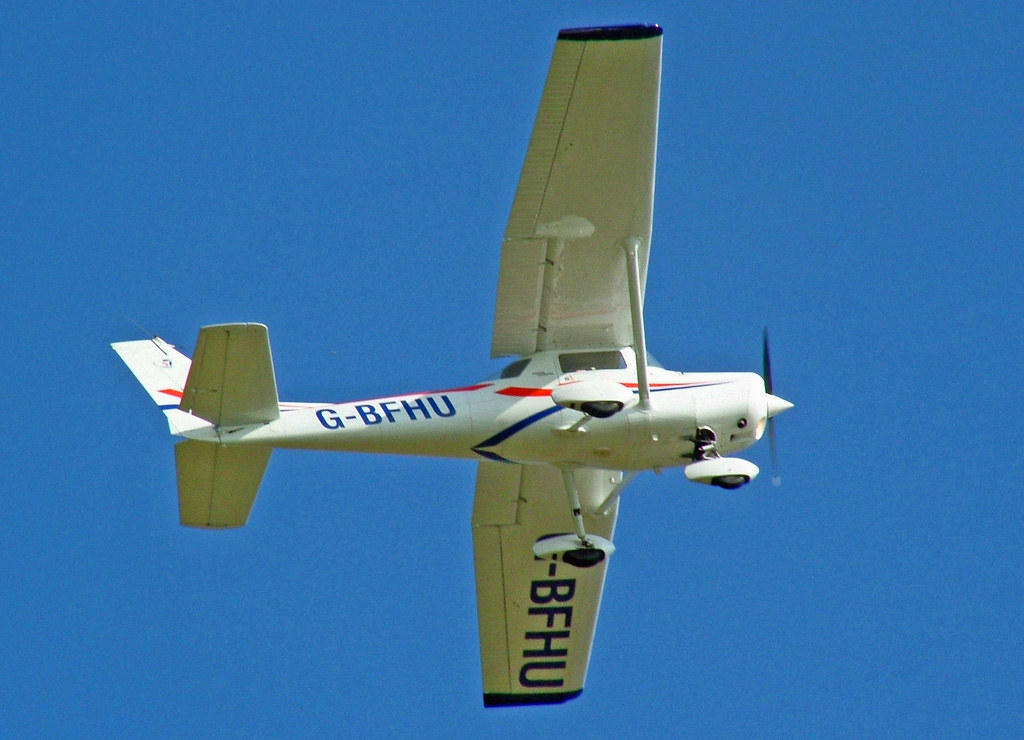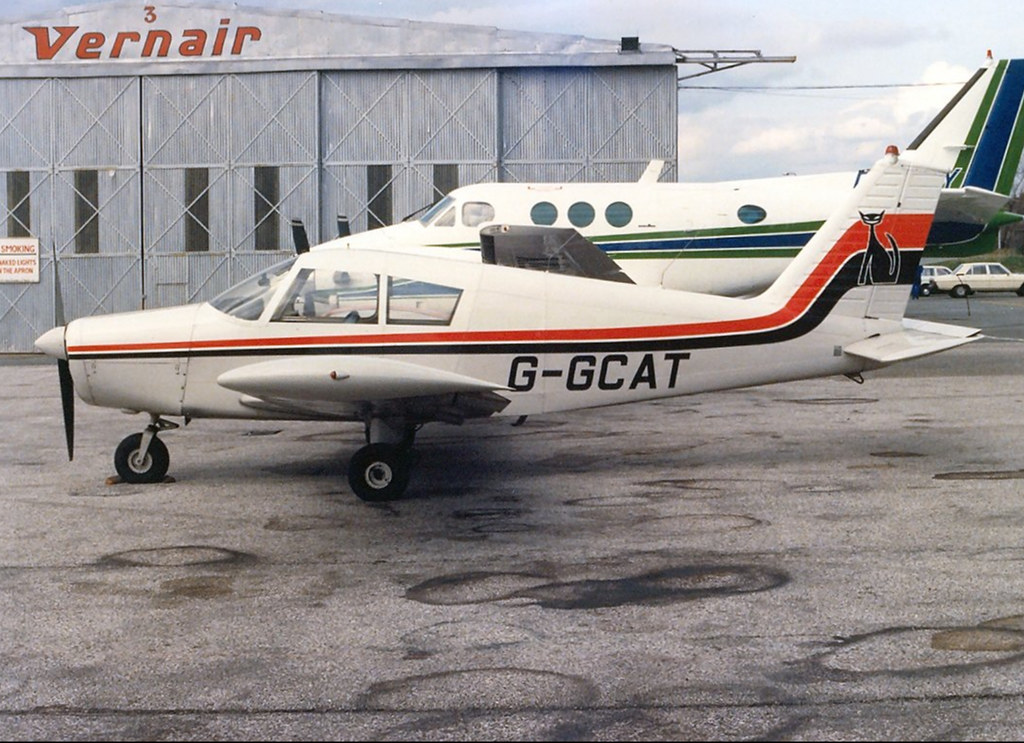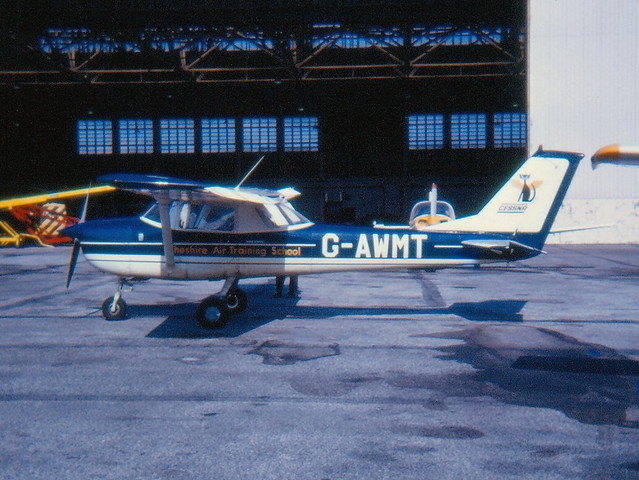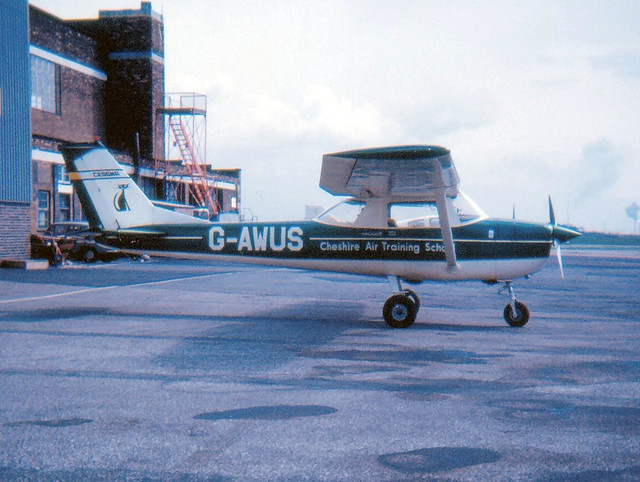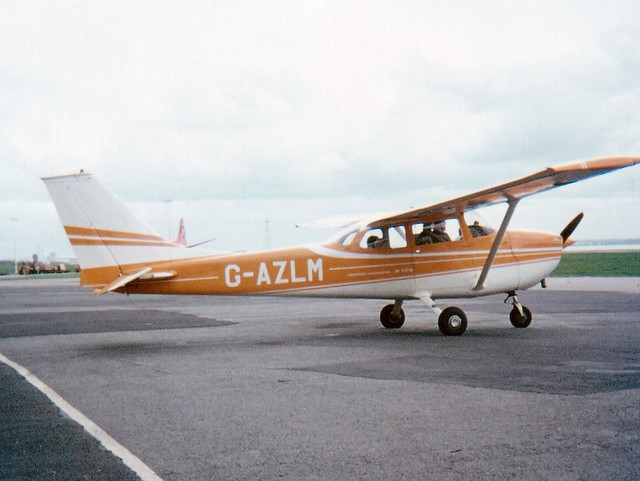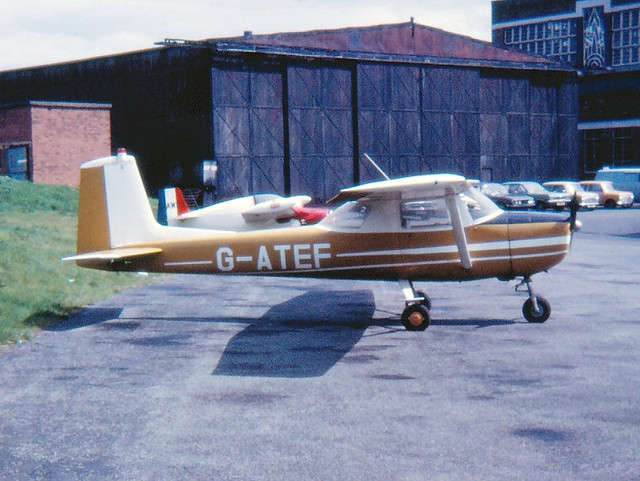Post by viscount on Jul 24, 2010 21:09:50 GMT 1
Cheshire Air Training School Ltd
Cheshire Air Training Services Ltd
Cheshire Air Training Services Ltd
Late October 2007 marked the demise of a respected and long-lived resident Airport company. Their fleet of, mainly, Cessna aircraft were often to be seen in the Liverpool circuit or parked on the GA apron between flights. On the tails, the stylised grinning 'Cheshire Cat' logo, distinctive trademark of the Cheshire Air Training School (CATS).
The genesis of this nwan forum entry is an article first published by FoLA in '09/27', summer 1990, written by Brian Jones with the assistance of John Huxley and Faye Birchall and approved by Dennis Dickinson. In May 1995, to mark their 25th anniversary, Brian Jones and Paul Ellison updated it in NWAN magazine. Updated again by Brian Jones to mark the companies demise, in FoLA's '09/27' winter 2008/09 edition. Thanks to editor Graham Ward for allowing me to use the article again here in its entirety.
Cheshire Air Training School, 1970 - 2007
Company Formation
Early in 1970 three instructors at the Shropshire Aero Club, tired of a restrictive club atmosphere at Sleap, got together to raise finance for a training aircraft of their own. Dennis Dickinson, Ernie Taylor, Gerald Sweeney and private pilot John Lindop jointly purchased a new Cessna 150 G-AWMT. Their initial plans centred on developing a flying club at Hawarden airfield near Chester - hence the choice of name and logo. The aircraft was delivered in the second week of June 1970 and business began in earnest on the 18th when the first pupil began tuition. However, Hawker Siddeley Aviation, the owners of Hawarden Airfield, imposed severe restrictions in the name of security, which made the operation of a flying training school almost impossible. After seven weeks of trying to make it work, on 22nd July 1970, CATS transferred across to Liverpool Airport. Initially members' cars acted as flight briefing and classroom for the three instructors. Soon a room near the then Airport Terminal was rented, before the purchase and erection of Portacabin type units next to the then Vernair Hangar No.3 in early 1971 for use as office, reception, flight-briefing, classroom and clubroom.
The arrival of a new flying club brought about much vocal opposition from the long established Liverpool Flying School, and for a time it looked as if CATS's stay at Liverpool would be temporary. However, CATS went on to prove that there was indeed sufficient business to keep both organisations busy. After a year of operating out of Liverpool, a second Cessna 150, G-AWUS, was acquired. The arrival of a second aircraft was of great benefit to both instructors and pupils. From the outset it was envisaged that CATS would be a flying school run with the highest degree of professionalism, concentrating on pilot training without the distraction of becoming a social club with licensed bar etc.
Steady Expansion
For summer 1972, the fleet line-up consisted of two Cessna 150s and a newly acquired four-seat Cessna 172, G-AZLM, along with use of member Dave William's Beagle Pup, G-AZEU. All four aircraft carried the grinning 'Cheshire Cat' logo on the fin. The following summer '73 the Beagle Pup was moved across to Hawarden by its owner to establish the basis of a new flying school called Deltair. However, its place in the fleet was filled with the purchase of a further, brand new, Cessna 150, G-BAYO. This four aircraft, all Cessna fleet was to form the basis of CATS for a number of years. The Cessna designs proved to be well liked, sturdy and adaptable in service with CATS.
As a busy and expanding organisation, CATS were approached to try other types, for example Robin DR.400 G-BAHL was demonstrated in July 1983, but the company remained committed to the trusty Cessna. It proving to be, as many other flying schools have found, to be an ideal training, cross-country and touring aircraft.
Air Display Participation
Under the leadership of Stefan Ratayak, CATS performed a lively routine for the 'Wings over Merseyside' air display on 29th April 1972 using both Cessna 150s. For the following years air show on 12th May 1973 the routine was developed, involving the two Cessna 150s resplendent with large German 'Iron Cross' logos and the Beagle Pup complete with over-size Royal Flying Corps (RFC) roundels! Needless to say the Beagle Pup won, having 'shot down' the opposition. A few years later, for an air show at Liverpool Airport on 8th July 1978 three Cessna 150s (G-AWMT, G-AWUS & G-BACD) flew a "stolen aircraft" routine - a highlight in an otherwise mediocre air display. At the 27th June 1982 Liverpool Air Show, two Cessna 150s (G-FAYE & G-BBCF) were again flown in a 'crazy' manner during a "stolen aircraft" routine.
Continued Expansion
In early 1976 a Cessna 150 Aerobat, G-BACD, was purchased, bringing the fleet up to five aircraft. The addition of this variant allowed basic aerobatic tuition to be provided, encouraging members to take their flying experience one step further with the company.
During June 1978, three of the original CATS directors were bought out, and the school became a family business under the joint directorship of Dennis Dickinson and daughter, Faye Birchall. This necessitated the sale of the original Cessna 150s G-AWMT and G-AWUS along with the original Cessna 172 G-AZLM. However, G-AWMT remained with CATS for a number of years on a leased basis, while two further Cessna 150s, G-ETUP and another Aerobat, G-BBCF, were leased early in 1979. In February 1979, a Cessna 172, G-BEWR, was purchased to replace the older, G-AZLM.
As a result of the rising demand for flying training and the consequent increase in members, by early 1980 CATS were operating a fleet of 8 aircraft. The two newest arrivals in February and March were Cessna 150 G-FAYE and Piper Cherokee G-BFRH. The Cherokee was purchased from a local member and was later reregistered as G-GCAT. The desired registration, G-CATS, was unavailable having been used on a Fairchild FC.2 in 1928 when the G-CA-- sequence was used for Canada. In conjunction with Cessna 172 G-BEWR, the Cherokee was often used for pleasure flights at weekends throughout the summers of 1980 and 1981 at least, operating from Gate 2 of the 'Art Deco' North Terminal.
In May 1981, while being flown on a night cross-country flight, Cessna 150 Aerobat G-BACD crashed on the high moors above Haslingden, killing the pilot. Although the Accident Investigation Bureau exonerated CATS of any blame, the press coverage was widespread, and not all of it very accurate - as is unfortunately frequent with any aircraft accident.
The lease on unreliable Cessna G-ETUP was terminated during July 1981. The original aircraft, Cessna 150 G-AWMT, was sold by the owner following an engine failure in 1982, so reducing the CATS fleet to five aircraft. The recession in the economy was at this time badly hitting the North West and especially companies offering top end 'luxury services'. The effect of the recession was partially offset in summer 1983 by CATS contracting to train a group of ten Air Training Corps cadets under a scholarship scheme. The cadets were chosen by the Aircrew Selection Centre at Biggin Hill as suitable for pilot training, then provided 30 hours of flying tuition at civilian flying schools, taking the cadet to (then) within 8 hours of PPL (Private Pilots Licence) examination.
During July 1983 Cessna 150 Aerobat G-BBCF was involved in a potentially nasty engine failure on take-off. The instructor skilfully brought off a safe dead-stick landing and although both occupants walked away unhurt, damage to the aircraft was considerable. The Aerobat was quickly replaced by another of the breed when G-BDNR was acquired in September 1983. Cherokee G-GCAT was sold in July 1984 and was replaced by a second Cessna 172, G-BFLV in summer 1985, bringing the fleet to a very workable mix of three Cessna 150s (one an Aerobat) and two Cessna 172s.
Split site, partial move to South Airfield
When Liverpool Airport moved passenger operations to the new terminal building on the South Airfield in April 1986, CATS also moved their offices and briefing room Portacabins to a new position west of the new apron and terminal building, usually operating off the grass. The aircraft were still kept in the rear section of Hangar No.3 on the North Airfield site, being taxied most mornings and evenings, with "Cats Combine" becoming a regular call to Liverpool's Air Traffic Control for taxi clearance between the two sites. This 'temporary' split operation was to continue until 1999!
Peak Years
Over the years the number of Air Training Corps cadets flying with CATS grew, with the professionalism and high standard of instruction offered always impressing the inspectors from the Central Flying School of the R.A.F., who each year checked on all the flying schools participating in the scheme. By summer 1986 the number of cadets was 24, in 1989 a total of 36, although the numbers slightly reduced in 1990. With the extra business generated, a further Cessna 150 was acquired in March 1986 in the form of G-ATRN, which was subsequently re-registered as G-SCAT. As the British economy recovered during the late '80s, so interest in flying as a leisure activity increased. In early 1987, late 1988 and autumn 1989 further Cessna 150s (G-AVIA, G-AWCM & G-BHUI) were added to the fleet, bringing the total to nine aircraft. From late 1988 the fleet was progressively repainted in matching paint schemes, retaining the well-known 'Cheshire Cat' logo proudly in the fin.
Twins and Other Activity
A new development in the company story was marked by their first twin-engined aircraft, a Piper Seneca, G-BSHA, in June 1990. Although CATS instructors had access to Merseyside Air Charter's Aztec 250 G-BAVZ from July 1982 and Chris William's Seneca G-CJWS from October 1988, this acquisition marked a step upwards for the flying school in its twentieth year. Piper Seneca G-BSHA remained in the CATS fleet for nearly two years, being returned to the lessor in March 1992.
1990 and 1991 marked the busiest years with a fleet of 10 aircraft. In summer 1990 CATS employed 4 full-time instructors, 3 full-time operations staff, 8 part-time instructors, 3 part-time Commercial pilots/instructors and two engineers. The school had approximately 250 members, including student pilots, PPL holders, trainee commercial pilots, ATC cadets and aerial photography clients.
Stiff competition
A third Cessna 172 G-BTMA was added to the fleet in September 1991, although it did not enter regular use until 1992. The years of 1992 and 1993 were difficult ones, with increased competition, not only from Liverpool Flying School and Air Nova (who had built up operations rapidly during 1989), but also from well established operator Deltair, who moved their base to Liverpool in January 1992.
In a somewhat bizarre incident on the ground at Liverpool, Cessna 150 Aerobat G-BDNR was damaged beyond repair in late January 1992, when it was run into by Deltair's Cessna 172 G-BIBW on the taxiway proceeding from the south to north airfields. The Aerobat was not replaced, so for much of 1992 and throughout 1993 the fleet remained constant at 9 aircraft - 6 Cessna 150s and 3 Cessna 172s. A novel move at the end of the year saw Cessna 150 G-SCAT depart to Blackpool in October, to return in February 1994 converted to a tail-wheel configuration. With an increase of interest in flying war-bird and vintage types, CATS could now offer members the opportunity to acquire the different skill-set required to handle tail-draggers.
Run-down towards a Change of Owners, late 1994
In Spring 1994 three Cessna 150/152s were sold, however for the summer season (April to August) Cessna 150 G-HIVE was leased in. One of the aircraft to depart in April 1994 was G-BAYO, the fourth aircraft to be acquired by CATS and had served 21 years since June 1973! The summer season featured 4 Cessna 150s (one a tail-dragger) and 3 Cessna 172s. However the disposals continued in the Autumn with Cessna 172 G-BRMA in September and both the Cessna 150 tail-dragger G-SCAT and another Cessna 172, G-BFLV in November 1994.
It was becoming clear that the Dickinson family, had decided 'for commercial reasons' that they would cease flying operations, realise the assets and close the company. However, a group of the school's Qualified Flying instructors agreed terms to purchase the remaining assets and the right to the reputation and goodwill of the company name. A new company was formed and registered as Cheshire Air Training Services Ltd, trading as Cheshire Air Training School.
Rebuilding the Fleet
The new company purchased the 3 remaining aircraft, Cessna 150s G-AVIA & G-FAYE and the Cessna 172 G-BEWR. These were destined to form the 'backbone' of the fleet for the next decade. The flying school remained busy and added a fourth aircraft to the fleet in March 1995, when a Slingsby T.67B G-BLTW was leased-in. Once again, CATS could offer aerobatic tuition to members. Through 1995 and much of 1996 two Slingsby T.67s were in the fleet, although the actual aircraft used changed as they rotated back to Turweston for maintenance. In 1997 the fleet expanded further, with Cessna 150 G-BOYU acquired on lease in August, while Cherokee Warrior G-BJYG, which was locally owned, was made available through the club for members to use. So for summer 1998, the fleet stood at six aircraft: 3 Cessna 150s, a Cessna 172, a Slingsby T.67B and use of a Cherokee. However at the end of the summer season the lease on Slingsby T.67B was terminated and G-BLTW returned to Turweston.
At long last, relocation
Cessna 150 G-BOYU was returned in March 1999, while Cessna 150 G-BGEA was leased in October 1999. For that summer the Club also used Cherokee Archer G-BGVZ on loan from a member, when required.
The big changes though, during 1999 were on the ground. In April, CATS and Air Nova had to vacate Hangar No.3 on the North Airfield so that it could be demolished as part of the re-development of Hangar No.1 for the David Lloyd Leisure Organisation. The aircraft were moved to the Spur 'Kilo' apron and were picketed out there overnight.
At the very end of September the Portacabins were moved from the grass to the west of the terminal and Post Office building, to a new location beside the east edge of the (as yet) unused General Aviation apron that had been laid down several months earlier. On 1st October, aircraft parking moved to the new GA apron 'Yankee'. After many years of temporary arrangements, the Flying School now had a permanent location for both clubroom with adjacently parked aircraft. This move brought about a general air of optimism; this despite increased rents, no hangarage and the arrival at Liverpool of more competition in the form of well-established Ravenair company, relocating from Manchester. In late 2001, CATS were close to commissioning a new, much needed, hangar for their fleet adjacent to the GA apron. however, this never happened, initially due to lease-hold conditions attached to building a hangar imposed by Peel Holdings, the Airport owners.
Further fleet changes
The lease on Cessna 150 G-BGEA was ended in December 2000, however in August 2001, locally owned Cessna 150 Aerobat G-BDOW was made available to members, with Cessn G-BFHU on a similar arrangement from August 2002. The Aerobat was sold by its owners August 2003 and the Cherokee Archer G-BJYG was lost when it ditched in Liverpool Bay 4th July 2004. The fleet for summer 2004 consisted of Cessna 150s G-ATRK, which had arrived in April on lease and the long serving G-AVIA & G-FAYE, along with Cessna 172 G-BEWR. During May 2005 Cessna 150 G-ATRK was returned to the lessor and Cessna 150 G-AVIA was sold after 26 years of service with the Flying School. However, Cherokee Warrior G-WARW was made available to the Club by its owners from early summer.
There was more shuffling of the fleet during 2006, another of the long-serving fleet members, Cessna 150 G-FAYE departed in August 2006, while in the other direction, G-AVIA returned (but this time on lease) in May and G-BDZC in August. So for summers 2006 and 2007 the fleet stood at 2 Cessna 150s, a Cessna 172 and use of a member's Cherokee Warrior. CATS had a reputation as a small, friendly, professional school offering training for PPL and associated ratings, employing 2 full-time and 3 part-time instructors, with around 150 members of which 45 were PPL students.
Towards the end
With competition from Liverpool Flying School and Ravenair becoming stronger, fuel more expensive and Liverpool Airport becoming much busier with airliner traffic, trading conditions were difficult. Just how difficult conditions had become became apparent at the very end of October 2007 when Cessna 150s G-AVIA and G-BDZC were returned to their lessors and the sole remaining company owned aircraft, Cessna 172 G-BEWR departed to Hawarden on 2nd November 2007, having served with the company for 28 years. With the office closed up, it quickly became known around the airport that CATS had ceased trading. So, sadly, after some 38 years, the much loved 'Cheshire Cat' logo had ceased aviating. Over the years CATS has made a considerable contribution to the GA scene at Liverpool Airport.
As so often is the case in the world of aviation, as one story ends another starts. Former instructors from CATS quickly formed Merseyflight and acquired their first aircraft, a Cessna 150 G-BCBX, which arrived at Liverpool during January 2008 to continue business where CATS had left off.









